Go Safe on Scotland's Roads: road safety framework to 2020
Go Safe on Scotland's Roads it's Everyone's Responsibility: Scotland's road safety framework to 2020.
Chapter Six
Being responsible on the roads
Research, statistics and feedback tell us that there are particularly vulnerable groups on the roads on which we need to focus our attention. The following sections address our priority vulnerable groups.
6.1 Children and Young People
The Issues
Children and young people are among the most vulnerable road users. Because of their age, many do not have the ability to make an accurate judgment about safe road use, while lack of experience of particular situations also means they are at greater risk. Children are often impulsive, easily distracted and unpredictable and for these reasons need special consideration by other road users.
Child casualties (i.e. under 16 years of age) killed and seriously injured ( KSI) have fallen significantly over the last ten years, as can be seen in Figure four. In 2007 there were nine child fatalities and 268 children seriously injured on Scotland's roads. This has decreased from the 1997 figure of 26 child fatalities and 719 children seriously injured.
Figure four: Children and young people road accident KSI by mode, 1997/2007
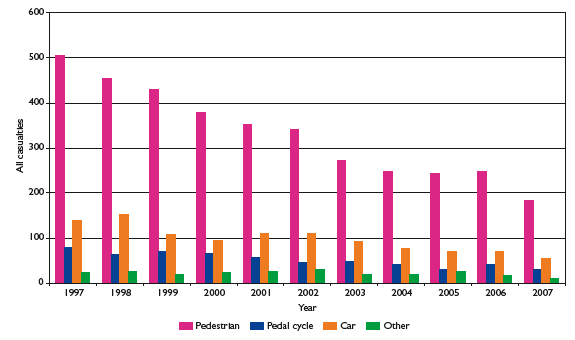
Despite the fall in child deaths and serious injuries, child deaths and the combined child KSI rate in Scotland in 2007 was higher per head of population than that of England and Wales, for both child pedestrians and child car passengers.
A review of road accident casualties, as part of research commissioned in 2007 12 by Road Safety Scotland ( RSS) into the S1/2 road safety education resource, showed that:
- The number of casualties increases as children move from primary to secondary school: 30% more children are killed or injured in the S1/S2 years than in the P6/P7 years;
- The number of child casualties occurring on journeys to/from school peaks around the age of 12, increasing almost threefold from the age of 10 to the age of 12; and
- The number of male pedestrian casualties up to age 13 was significantly greater than female casualties.
Figure five shows that, as children enter their teenage years, their casualty rate increases. Research suggests that this may be due to their enhanced freedom, travelling further from home and being out in hours of darkness and in adverse weather conditions. Research carried out in 1998 13 highlighted that, although road safety knowledge among this age group was high, the application of this knowledge was poor.
Figure five: Child killed and seriously injured by age, 2007
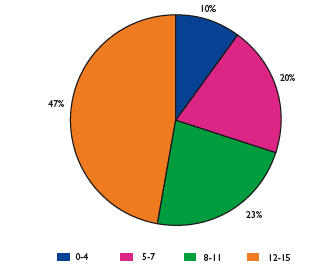
A further issue relates to children with additional support needs. Learning to use the roads safely is a key life skill for such children as this can lead to greater independence. A study published in 2005 14 investigated the existing road safety education provision for young people within a wide spectrum of additional support needs. It suggested that these young people can be at higher risk of road accidents due to a variety of factors, including lack of awareness, inability to cope with change, difficulties putting theory into practice or specific difficulties with spatial awareness.
The study further explained that the travel patterns of children with additional support needs are often more restricted than those without, with travel to school predominantly by taxi, bus or car. There was some concern that, due to restricted travel patterns and methods, many children are missing out on the basics of road safety education.
Finally, research has shown that children in the lowest socio-economic groups are over four times more likely to be killed as pedestrians than those in the highest socio-economic group. 15 The risk of pedestrian injury is over 50% higher for children of single mothers compared with two parent families and significant differences in child pedestrian injury rates based on ethnicity have been identified, particularly for younger 'non-white' children.
What we do now
DfT published a Child Road Safety Strategy in 2007 www.dft.gov.uk/pgr/roadsafety/child/childrdsafetystrategy2007 . The document describes actions specifically focused on children's road safety across the UK, including in Scotland. Road safety education and publicity are devolved issues. While supporting much of the content of the DfT document, RSS provides a cohesive and co-ordinated suite of educational resources for children in Scottish schools, as well as road safety publicity campaigns and materials.
RSS is implementing an overarching strategy for road safety education, www.road-safety.org.uk/education/national_strategy/index.asp , that sits within the Scottish Government framework for education - Curriculum for Excellence. The strategy covers all stages of a child's road safety education within both formal education and wider community settings, from pre-school through to secondary, and includes young people with additional support needs. It aims to ensure that a core of road safety is taught to all children, with overarching links to other areas within the curriculum.
RSS has also developed a range of resources that are available, free of charge, for use in all schools from early years through to secondary and college, school clubs, youth and community groups, outreach education, and faculties of education. They are also available to adult literacy classes in Scotland. A list of RSS educational resources is at Annex C. The resources enable children and young people to understand the nature of risk, employ safety strategies and perceive the road environment as a shared space. There are also a number of websites designed by RSS to support and enhance education resources and initiatives for children. A list of the web links is also included at Annex C.
In addition to classroom based learning, children benefit from practical training as pedestrians. Some local authorities have successfully implemented Kerbcraft, a child pedestrian training resource developed by the University of Strathclyde with funding from the UK Government, and initially piloted in the Drumchapel area of Glasgow.
| 'Kerbcraft' West Dunbartonshire West Dunbartonshire is one local authority where Kerbcraft has been introduced. The scheme aims to teach children three pedestrian skills:
The scheme is unique in that parents, grandparents and guardians volunteer to train the children after receiving training from the scheme co-ordinator. Kerbcraft has delivered training to over 1,200 children within West Dunbartonshire and has now become a firm favourite within the school timetable. The scheme helps not only to deliver key pedestrian skills, but also promotes health and well being. 42% of volunteers have utilised their Kerbcraft skills to enter into the workplace and further education. The training volunteers receive reaches further than just Road Safety. Training is provided for interview skills, time management, assertiveness, team building, interactive communication and presentation skills. These skills are often sought after by employers and further education establishments and have delivered real benefits to local people. The Kerbcraft website can be accessed at: www.kerbcraft.org |
The Scottish Government is committed to encouraging those children who are able to walk and cycle to school. Currently one in five vehicles at peak times in the morning and afternoon is on the 'school run'. By promoting active travel we will improve children's health and well being as well as reducing congestion and CO 2 emissions. Figure six shows the different modes of transport, undertaken by pupils in full-time education, for school journeys in Scotland.
Figure six: Travel to school - usual method, 2007
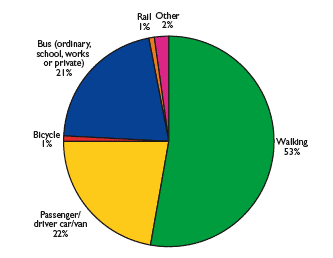
Source: Scottish Household Survey 2007
If parents allow their children to walk and cycle to school they need to feel that their children will be safe in doing so. Many schools have produced School Travel Plans under the Safe Routes to School initiative. These are supported by School Travel Co-ordinators who are employed by some local authorities. Their main tasks can include encouraging and supporting the work of school travel teams; getting schools to sign up to developing a travel plan; supporting schools throughout the travel plan process; monitoring travel plans; and working directly in schools on their plans.
One example of a community led initiative to ensure safer travel to school as part of the school travel plan is the Strathyre Traffic Campaign.
| In August 2007, the P4-7 children of Strathyre Primary School in Stirlingshire embarked on a traffic/safe routes to school campaign as part of their health programme. This involved investigating dangers in the environment and strategies for keeping themselves safe. The children decided to tackle the danger of traffic passing through their village at speed. It was decided that the lack of an adequate pavement in the village should also be addressed. The children drew up a set of aims that included investigating the speed and volume of traffic passing through the village and exploring the possibility of an alternative route to school using an old existing railway track. In order to gather the views of all families and local villagers, the children devised a questionnaire that was distributed to all interested parties. The children also carried out various traffic surveys, monitoring the speed, volume, types of traffic and times of high usage over a period of time. This information was the subject of a presentation to the local MSP, School Travel Co-ordinator, representatives from the Schools Partnership and parents in October 2007. Subsequently, a meeting took place with the Scottish Transport Minister and an action plan was drawn up. An initial inspection of pavements has been carried out. Further traffic surveys have been conducted at different times of the week/year, as agreed with the Headteacher, to determine whether a pedestrian crossing is required at Strathyre. In addition, flashing 30 mph speed signs are to be installed at either end of the village. The school will be consulted and the views of staff, parents, children and local villagers will be taken into consideration throughout the scheme, which will improve safety for children and other pedestrians in the village. |
Local authorities have statutory responsibility for school transport provision. While Ministers cannot intervene in such decisions, nor set conditions on how the responsibilities are discharged, the Scottish Government provides guidance to education authorities on school transport issues. In March 2007, a publication on School transport: survey of good practice ( www.scotland.gov.uk/Publications/2007/03/16091028/0 ) was issued. It sets out examples of good practice in school transport provision and examples of successful strategies for distancing cars from schools and encouraging walking and cycling.
Each day in Scotland, pupils are transported to and from school by school bus. Across the country, and particularly in rural areas, concerns have been expressed by parents over the safety of pupils getting on and off these buses at the pick up and drop off points ( PUDOs). The Scottish Government is currently examining the potential for increased visibility of school buses and school children with Aberdeenshire Council. Suggestions for improvement include redesigning the current sign for school buses, putting in place additional signs, introducing high visibility clothing for pupils, and interactive signing to raise drivers' awareness of the presence of school buses and school pupils.
Given that the critical aspects of ensuring that pupils are transported safely relate to their own responsibilities, and that of their parents and other drivers, there is also a clear opportunity for all partners to maximise the use of the media to promote joint, co-ordinated messages to pupils, parents and drivers regarding the issue of road safety and school transport.
The Scottish Government has also encouraged and funded specific initiatives to protect child pedestrians, including a scheme to implement 20 mph limits around schools. Nearly £50 million was made available to local authorities between 2003 and 2008 for the introduction of 20 mph schemes at schools. By March 2008, 20 mph speed limits were in place at 83% of schools. The Scottish Government continues to support and encourage children walking and cycling to school in safety through provision of funds to the Sustrans School Run Team and cycle training resources from RSS and Cycling Scotland.
What we need to do next
As noted earlier, Scotland compares less favourably with England and Wales regarding children killed and seriously injured in road accidents. We need to reduce these accidents further, in line with the child road safety targets outlined in Chapter Two.
RSS has gained national and international recognition for the excellence and relevance of its educational and publicity products. We want to maintain that excellence and continue to lead the way with innovative road safety education products and publicity messages.
In order to promote a Fairer Scotland we cannot tolerate any differences in road safety between children living in disadvantaged or affluent areas, nor any due to ethnicity, disability or any other equality issue. So we will continue to investigate how best to ensure that all children are safer on Scotland's roads.
To develop a Healthier Scotland we want to encourage our children to have a healthy lifestyle and, where possible, to walk or cycle to school. We want them to be able to do this in safety and we want everyone concerned to have the opportunity to be involved in planning how to do this.
Commitments
In Government, and in partnership with other stakeholders, we will:
- Aim to achieve our ambitious child casualty reduction targets by 2020 by scrutinising the circumstances of each child fatality and reporting to Scottish Ministers with recommendations for action.
- Fund Road Safety Scotland to develop innovative road safety educational resources (including a new Early Years' resource to replace the Children's Traffic Club in Scotland).
- Undertake an audit of our road safety education resources to ensure they address the specific issues which Scotland's child road casualty record presents and that they keep pace with educational developments and methods.
- Commission new research to investigate the links between road safety and disadvantaged children and those in ethnic minority groups and implement agreed action.
- Continue to support the use of school travel plans, fully involving the local community, through grant to the Sustrans School Run Team and cycle training resources from RSS and Cycling Scotland.
- Investigate, report and implement ways to help ensure schoolchildren's safety when getting on and off school buses.
- Call on the UK Government to consider any strengthening of legislation in relation to school transport.
What we all can do:
- Teach children never to cross the road before looking all around including behind them if at a junction.
- Teach them to use a pedestrian crossing, where available, and teach them not to assume that the driver has seen them and can stop.
- Be aware that children are greatly influenced by our behaviour on the roads: and so keep them safe by showing them how to use roads responsibly; give them as much practice as possible at being safe pedestrians; and help them improve their skills of judging speed and distance of moving vehicles and the decision making process of crossing the road.
- Be extra vigilant when driving or cycling in areas where there are children playing, cycling, walking, or alighting from school buses.
6.2 Pedestrians
The Issues
In 2007, 17% of all road casualties in Scotland were pedestrians. Figure seven shows a decrease in pedestrian casualties from a total of 87 deaths and 1,124 serious injuries in 1997 to 60 deaths and 592 serious injuries in 2007. Although a welcome decline, the vulnerability of pedestrians is illustrated by the fact that they are almost twice as likely as car occupants to be killed or seriously injured when involved in a road accident (652 KSI from a total of 2,696 pedestrian casualties compared to 1,270 KSI from a total of 10,054 car occupant casualties).
Figure seven: Pedestrian road casualties by severity, 1997/2007
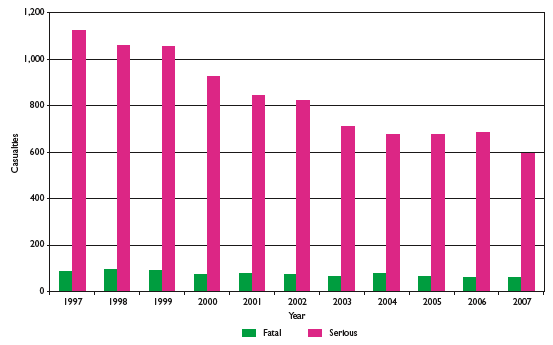
We have already discussed child pedestrian casualties in Section 6.1. However, another age group which gives cause for concern is the over 70s. Perhaps because of the increased frailty of this age group there is a high number of pedestrian fatalities proportionate to the overall number of casualties.
Pedestrian fatalities and serious injuries have a particular predominance in urban areas. This points to a need to ensure that vulnerable road users are protected more in such areas and that pedestrians themselves act responsibly amongst traffic.
There is also a particular issue regarding alcohol-impaired pedestrians. Samples carried out by the Coroner & Procurators' Fiscal office show almost 40% of pedestrian road fatalities in Great Britain had alcohol levels over the legal limit for driving. Nearly three quarters of those killed in road accidents between 10pm and 4am were over the legal drink drive limit. 16 Figure eight shows the number of pedestrian casualties in Scotland in 2005 to 2007 where the reporting officer has thought their impairment through alcohol may have played a role in the accident.
Figure eight: Pedestrian road casualties in Scotland "impaired by alcohol" listed as contributory factor, 2005 to 2007
| Fatal |
Serious |
Slight |
Total |
|
|---|---|---|---|---|
| 2005 |
13 |
106 |
306 |
425 |
| 2006 |
16 |
125 |
295 |
436 |
| 2007 |
16 |
94 |
284 |
394 |
Source: Stats 19 Contributory Factors Data
We will monitor these figures to ascertain whether alcohol impairment continues to be an increasing contributory factor in pedestrian fatalities.
What we do now
The Scottish Government provides resources to local authorities, Sustrans, Living Streets and Cycling Scotland for various interventions that promote active travel. For example, funding is available through the Cycling, Walking and Safer Streets programme ( CWSS) for crossing facilities for pedestrians and cyclists, improved footpaths and shared use paths, traffic free entrances outside schools, 20 mph limits and improved street lighting.
We know that more than half of pedestrian accidents occur within 2 kilometres of the casualty's home and we therefore need some focus on residential areas. We want new streets to be designed that take into account the needs of pedestrians and cyclists.
| Designing Streets Designing Streets is a Scottish Government document which, when published, will complement Designing Places by setting the policy and guidance for design, construction, adoption and maintenance of new streets; it is also applicable to existing streets subject to re-design. Designing Streets updates the link between planning, transportation policy and street design. It places particular emphasis on the importance and benefits that flow from good design and assigns a higher priority to pedestrians and cyclists. It also highlights the linkage between street design and a range of other policy objectives including, and especially, road safety as it reinforces the priority of pedestrians and cyclists and provides guidance on design in controlling and reducing vehicle speeds. |
The Scottish Government has encouraged the use of 20 mph speed limits in residential areas and, as mentioned in Section 6.1, around schools. Local authorities are well placed to decide on 20 mph speed limits in their areas and whether they should also be accompanied by speed calming measures such as road humps.
| 20 mph Speed Limits in East Ayrshire East Ayrshire Council has provided full-time and part-time 20 mph speed limits on roads adjacent to 56 schools. In addition 20 mph speed limits have been introduced in 38 residential areas and there are 45 'Twenty's Plenty' Zones. A questionnaire survey undertaken during the consultations on the Local Transport Strategy indicated that 92% of residents in East Ayrshire support reduction in speeds in residential areas. Two-thirds of residents that responded supported the use of road humps to help drivers reduce their speed. The programme of introducing 20 mph speed limits is continuing in residential areas to reduce casualties, enhance the environment and make it easier for the elderly, disabled people and young people to move around residential areas in safety. |
RSS provides an interactive education resource a2bsafely on-line and as a CD. It gives young people and young adults a safe place to explore the road environment as pedestrians. This is supported by RSS's Step-by-Step pocket booklet which has been produced in English, Gaelic and Polish, to provide a simple guide for students and parents.
What we need to do next
We need to continue to work with those responsible for designing and planning Scotland's road network. We want a consistent and appropriate standard that addresses the road safety needs of all who make journeys on foot (particularly children and the over 70s) and that also takes into account the safety requirements of disabled people such as the visually impaired.
We want to encourage people of all ages, abilities and diversities to walk in safety in order to make themselves healthier and to help improve Scotland's air quality through a decrease in vehicle use and corresponding emissions.
We want to investigate whether alcohol is playing a greater part in pedestrian casualties and, if it is, consider what we can do to reverse the trend.
Commitments
In Government, and in partnership with other stakeholders, we will:
- Publish guidance for Scottish roads authorities on designing streets, focusing on the needs of pedestrians of all abilities.
- Encourage local authorities to consider 20 mph speed limits in all residential areas.
- Investigate whether alcohol is playing a greater part in pedestrian casualties and, if it is, consider what we can do to reverse the trend.
What we all can do:
- Increase the number of journeys we make on foot and encourage others to do the same.
- Adopt safe practices in accordance with RSS publicity.
- Follow advice contained within the Highway Code.
- Pay greater attention to the vulnerability and needs of pedestrians when we cycle or drive.
6.3 Motorcyclists
The Issues
Increasingly, people are using motorcycles for travel and recreation. Unfortunately, this increased usage is also reflected in a rise in the number of motorcyclist casualties in Scotland. Evidence suggests more and more middle-aged men are buying motorcycles and there is a corresponding increase in motorcycle casualties for this age group as Figure nine shows.
Figure nine: Motorcyclist casualties by gender and age, 2007
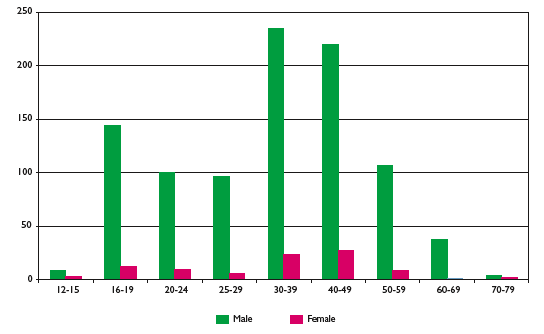
In terms of the number of casualties, motorcyclists come third after car occupants and pedestrians, but they are proportionately more at risk of being killed or injured in a road accident than any other type of road user.
As can be seen from Figure ten, the numbers of seriously injured motorcyclists peaked in 2000, but they do not show the same steady decline as that of other groups of road users.
Figure ten: Motorcyclists killed and seriously injured, 1997 to 2007
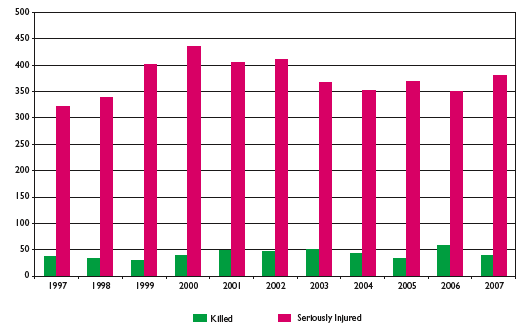
Two pieces of research commissioned by RSS have examined the issue of motorcycle accidents in recent years. The first, published in 2004, 17 studied 11 years of accident data and sought to investigate the surrounding circumstances of motorcycle accidents and identify behaviours or circumstances that increase accident risk. The second, published in 2006, 18 considered motorcyclists' attitudes to risk.
These studies provided valuable insight into motorcyclist safety issues, which is now informing publicity aimed at reducing casualties. Amongst the key findings were the fact that most accidents happen on rural roads, at the weekends and in the summer months reflecting the fact that recreational motorcycling is becoming more popular. The 2006 report also found that most riders have a reasonably realistic view of the risks involved in motorcycling but are willing to accept them.
What we do now
Guidance for road authorities in Scotland on motorcycling issues was published in 2007 on the Scottish Government website. 19 The guidance was prepared by the Scottish motorcycling community and endorsed by the Scottish Government.
An initiative called Bikesafe is run by police forces in conjunction with RSS, motorcycling groups and other partners. It seeks to provide an assessment of skills and extra theory training for those who are keen to improve their riding skills, and is aimed at lowering the number of motorcycle rider casualties. It is offered free of charge to participants.
Bikesafe provides presentations on many aspects of motorcycling, including professional riding techniques, the police system of motorcycle control, collision causation factors and defensive riding. Practical on road assessments and demonstration rides allow participants a further insight into advanced riding. By passing on their knowledge, skills and experience, police motorcyclists can help participants become safer and more competent riders. Further details are at www.bikesafe.co.uk . Other organisations also offer additional and advanced training including the Institute of Advance Motorists ( IAM) ( www.iamtrust.org.uk ) and RoSPA ( www.roadar.org ).
In addition, police forces around the country are engaging with, and encouraging, motorcyclists to ride more safely. One initiative which has met with success is Lothian and Borders 'Around the Corner' campaign.
| 'Around the Corner' - Lothian and Borders Police In the period 2003 to 2007, of all the drivers/riders killed in collisions on the roads in the Lothian and Borders Police (L & B) area, 26% were motorcyclists, with the greatest majority occurring in the Scottish Borders. Serious collisions increased by 46% between 2006 and 2007. In 2007 L & B Police embarked on a campaign called 'Around the Corner' which was designed to interact with motorcyclists, those who live locally, as well as visitors. The objective was to influence rider behaviour through education, engagement, empathy and encouragement. Road Policing resources, previously engaged solely in an enforcement role, are now utilised to engage with motorcyclists. At identified rest halts, and on the roads known to be used by bikers, Officers conducted high profile patrols but with the added task of stopping and engaging with riders. They are specifically tasked with encouraging safer riding, developing skills and signposting towards further rider education. Pivotal to this campaign is a dedicated website. Based on roads where serious collisions occurred, routes were devised and published on the website and in the form of hand out 'snap fax'. The routes highlight, both in text and video footage, specific locations where incidents had occurred to advise on the nature of hazards and rider technique. The campaign was launched at the Scottish Motorcycle Show in 2007 and again in 2008 by personalities from the motorcycling world who endorsed the campaign throughout the seasons. |
Partners for the 'Around the Corner' campaign include Knockhill Race Circuit, Eastern & Western Motor Group, Scottish Borders Council and Lothian and Borders Safety Camera Partnership. The campaign also receives assistance and promotion through various motorcycle outlets throughout the Force area and retail outlets that bikers are known to frequent.
Independent assessment of the campaign and the website is very positive; in particular bikers welcomed the advice and interaction from their professional peers.
Future developments will include additional routes to provide further interest/guidance and riding tips along with new branding. Expansion of comprehensive riding techniques, motorcycle maintenance, etc will be a priority for the 2009 season. Rider first aid is also being considered.
The website can be accessed at www.aroundthecorner.org.uk .
There are a number of websites for motorcyclists that offer safety advice. RSS has undertaken to provide a portal for these to form a more cohesive package of information for the motorcyclist.
Motorcyclists can, of course, take steps to safeguard themselves, by wearing good quality helmets and appropriate clothing, and by ensuring that they are visible to other road users. Information is provided on the 'Directgov' website: www.direct.gov.uk/en/Motoring/LearnerAndNewDrivers/RidingMotorcyclesAndMopeds/DG_4022434 .
There are also many engineering initiatives to help protect motorcyclists. Some of these are discussed in Chapter Nine.
What we need to do next
We want to reverse the trend in motorcyclist fatalities. We want to help ensure safe riding through education and training of both motorcyclists and drivers of other vehicles. We want to find ways to decrease the risks and risk taking without inhibiting the enjoyment of riding.
Commitments
In Government, and in partnership with other stakeholders, we will:
- Encourage training and support for motorcyclists, e.g. through Bikesafe and other advanced rider training schemes.
- Develop a website which provides a link to all sites providing information on a range of issues, including safety, of interest to motorcyclists.
- Through RSS, support targeted publicity campaigns aimed at motorcyclists.
- Consider the needs and vulnerabilities of motorcyclists when designing new roads and implementing safety features on existing roads.
What we all can do:
- Motorcyclists can ensure they are visible in traffic and wear appropriate protective clothing.
- Motorcyclists can take further training, including consulting websites such as those highlighted in this section, to enhance and advance their riding skills.
- Drivers can pay greater attention to the needs and vulnerability of motorcyclists.
- Drivers can ensure that they do not overfill diesel tanks as spillage is a significant hazard to motorcyclists.
6.4 Pedal Cyclists
The Issues
Figure eleven shows that cycling fatalities and serious injuries have fluctuated over the past ten years. Fatalities have decreased since 2005 with a total of four deaths in 2007, but there has been an increase in serious injuries in the same period.
Figure eleven: Pedal cyclists casualties by severity, 1997 to 2007
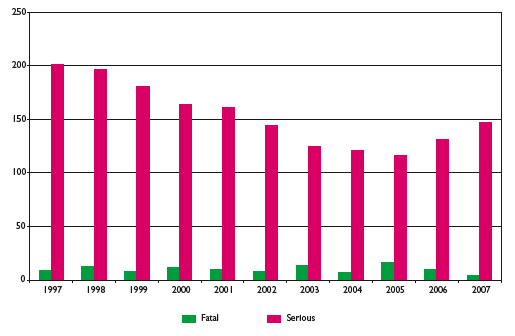
Research in 2005 20 confirmed that males were over three times more likely than females to be involved in cycling accidents and that only one-third of all cycling casualties resulted from 'on road' incidents. It also showed that adult cyclists were more likely than child cyclists to be involved in a collision with a car.
During the summer of 2008, an extensive consultation exercise was carried out to find out what should be included in a Cycling Action Plan for Scotland to encourage more people to cycle. The consultation found that the most significant reason why people did not cycle or did not cycle more often, was a perception of safety. Over three-quarters of respondents said that less traffic, and two-thirds said slower traffic would encourage them to cycle more often.
What we do now
As part of its education programme, RSS is responsible for maintaining the Scottish Cycle Training Scheme ( SCTS) and co-ordinating the development and production of its materials. The SCTS was adopted as the principal child cyclist training resource in Scottish schools by all 22 road safety units in 2005. It is an introductory course designed to give P6/7 pupils the basic skills and knowledge they need to ride safely on the road.
| Scottish Cycle Training Scheme, Argyll and Bute Child cyclist training in Argyll and Bute was recognised as an example of good practice by Cycling Scotland in their National Assessment of Local Authority Cycling Policy, published in May 2008. Child cyclist training takes place 'on road' in 74 of the 80 primary schools in Argyll and Bute and is seen as an integral part of road safety education. 'On road' training is considered as an investment in the future as it provides tomorrow's drivers with a more holistic appreciation of road safety. Road Safety staff select each 'on road' site after carrying out a risk assessment and the location is logged along with photographs and a site plan. Instructors, recruited by Head Teachers, are then trained by Road Safety staff to deliver SCTS. Instructors also visit the training site to be advised where the 'Child Cycle Training' warning signs should be located and of the necessity to wear high visibility clothing. New instructors are offered additional support visits. Training is usually carried out over a six week period, starting off in the playground and moving to the road on week four. The pupil to instructor ratio is 8:1 with a minimum of two instructors. Before the test, schools are asked to enter pupil names onto a spreadsheet which is downloaded to a Personal Digital Assistant ( PDA). A formal test is conducted and data collected on the PDA. At the end, pupils and instructors are provided with feedback on their performance. Instructors are also encouraged to comment on the Scheme materials. On completion of the test, all data is e-mailed from the PDA to office support staff who print test result sheets for all and certificates for successful candidates. Data collected electronically can easily be analysed to identify instructor training needs or to measure annual performance. |
Through Scottish Government funding to Cycling Scotland, around 120 cycle trainers are being trained each year to increase the numbers of those available to provide 'on road' cycle training tutorials and to increase the 10% of children who currently receive the training, as recommended by RoSPA. Cycling Scotland produces P5 and P7 resources to complement those of the SCTS.
RSS co-ordinates the Safe Cycling Working Group, whose membership is drawn from various organisations including Road Safety Units, Cycling Scotland, Sustrans and the Scottish Government's Sustainable Transport Team. The Group meets on average two or three times a year to consider how best to support the promotion of safer cycling in the road environment. In 2006, RSS commissioned the development of a micro-website, www.whereisthelove.tv , to engage with those cyclists and motorists who use the road on a daily basis. The main thrust was to remind road users that both cyclists and motorists have equal status on the road and that they should 'look out' for each other. The Group is also responsible for development of the SCTS and is currently preparing a resource which will standardise how SCTS instructors are trained.
What we need to do next
Responses to the consultation for this Framework were equally supportive of the need for cyclists to be responsible on the roads and the need for other road users to act responsibly towards cyclists. We will continue to facilitate and encourage safe cycling in Scotland through education and training for cyclists and raising awareness for other road users.
We would also encourage consideration of cyclists when road design and maintenance schemes are being conceived. This can range from creating new or upgrading existing cycle paths to providing space for cyclists on shared roads.
In the interests of safety, we support cyclists taking sensible precautions by wearing appropriate protection, including cycling helmets and high visibility clothing, so that they are visible to motorists and other road users.
Commitments
In Government, and in partnership with other stakeholders, we will:
- Develop a Cycling Action Plan for Scotland to achieve the overarching outcome of 'more people cycling more often'. One action will be to increase the numbers of children receiving cycle training and therefore promoting road safety.
- Ensure that all road users receive appropriate education and training messages about cycling in the road environment, including journeys to and from school and in residential areas.
- Continue to monitor and develop SCTS resources for dissemination to Road Safety Units and others responsible for co-ordinating the SCTS programmes.
- Encourage the wearing of correctly fitted helmets by cyclists, especially children.
- Ensure cyclists are considered in new road and maintenance schemes.
What we all can do:
- Increase the number of journeys we make by bicycle and encourage others to do the same.
- Adopt safe practices in accordance with RSS publicity and advice contained within the Highway Code.
- Pay greater attention to the needs of cyclists when we are driving.
There is a problem
Thanks for your feedback